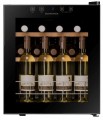Number of bottles
The maximum number of standard wine bottles (straight, Bordeaux type) that the cooler is designed to store.
The increase in capacity affects the dimensions and price of the entire device. So for private home use, a
compact wine coolers of small capacity (up to 20 bottles) can be the best choice — especially since the height of such devices is usually small. However,
low wine coolers can store more contents —
24 – 25 bottles or more. Models with a capacity of
50 – 80 bottles are already designed mainly for bars and restaurants, but they can also be useful for enthusiastic wine collectors; and the most voluminous of modern wine coolers can hold
noticeably more than 80 bottles — in some units up to two or three hundred.
It is also worth noting that it is not recommended to fill wine coolers to their full capacity. The actual occupancy should be at least 30 percent lower than the maximum. So, when choosing, it is worth making an appropriate margin.
Total volume
The total volume of the wine cooler working chamber (chambers).
Although the main spec of such units is the number of bottles (see above), volume data can also be useful when evaluating and comparing different models. The fact is that with the same capacity, a larger volume means better air circulation and more efficient temperature distribution. On the other hand, an increase in volume also increases the price and dimensions — and there may simply not be free space for
a wide or
high wine cooler.
Number of shelves
The number of shelves provided in the design of the wine cabinet.
Such shelves are usually mounted on rails and can be removed if necessary. In some models, they can also be rearranged to another level. All this can be useful for organizing the space inside the cooler — for example, to accommodate large bottles of increased thickness, you can remove one of the shelves, providing the right amount of needed space. As for the quantity, it is selected by the manufacturer, taking into account the capacity, width and height of the working chamber, so this parameter is not that important when choosing.
Shelves material
The material from which the shelves of the wine cooler are made.
— Wooden.
Wooden shelves are considered the most suitable option for storing wine. It is because the wood smooths out vibrations additionally, which helps protect the bottles from unwanted shocks. In addition, this material looks good and provides a certain style to the wine cooler. Therefore, more or less advanced models that allow long-term storage of wine are equipped mainly with wooden shelves.
— Metal. Shelves of this type are made of thick wire and are grids with bars of a special curved shape: the bends of such bars play the role of "seats" for bottles. Such grids are somewhat cheaper than a wooden ones. Moreover, they almost do not block the air movement in the working chamber and contribute to the evenest temperature distribution inside. On the other hand, metal, unlike wood, almost does not absorb vibrations and therefore is considered suitable mainly for relatively short-term storage of wines.
Energy class
The energy efficiency class characterizes how economically the wine cabinet consumes electricity. The highest class among modern units is A ++, then A +, A, B, C and further alphabetically.
Note that in this case, it is not energy consumption that is taken into account but consumption in comparison with units having similar specs (and the same type of cooling, see above). Therefore, a professional 80-bottle A++ wine cooler will consume more energy than a 15-bottle C-class unit. We also note that more economical devices have a higher price. However, they have a lower cost of maintenance during their life span.
Energy consumption per year
It is the amount of energy consumed by the wine cooler in a year during normal operation. Of course, the actual consumption will inevitably differ from this indicator in one direction or another, but these differences are usually not fundamental. So this indicator makes it possible to evaluate the efficiency of different models and compare them with each other. Recall that more energy-efficient units cost more on their own, but in the end, they can turn out to be more profitable due to energy savings.
Climate class
The climate class to which the wine cabinet corresponds.
As the name implies, this parameter describes the environmental conditions for which the unit was designed. The warmer it is around, the more powerful the wine cabinet should be and the better thermal insulation it should have. Specific classes are indicated by letters. Here are the most popular options:
— SN (subnormal). Models for a cool temperate climate have an operating range from +10 °C to + 32 °C. Such a unit can be useful in a poorly heated room where the temperature can drop below +16 °C — for example, on the veranda of a private house, in a garage, etc.
— N (normal). Wine cabinets for temperate climates, with an operating temperature range of +16...+32 °C. Such a unit is suitable for most residential apartments and houses in mid-latitudes.
— ST (subtropical). Models for subtropical and humid tropical climates. Normally they work at the range of external temperatures +18...+38 °C.
— T (tropical). Wine coolers for dry tropical climates. Designed for temperature range +18 °C to +43 °C.
Also, note that there are many models on the market with an extended temperature range covering several classes. For example, a unit labelled N-ST will have a temperature range of +16...+38 °C. Such models are indispensable in complex climates, the conditions of which are not covered by one standard class — for example, in cold winters and hot summers.

